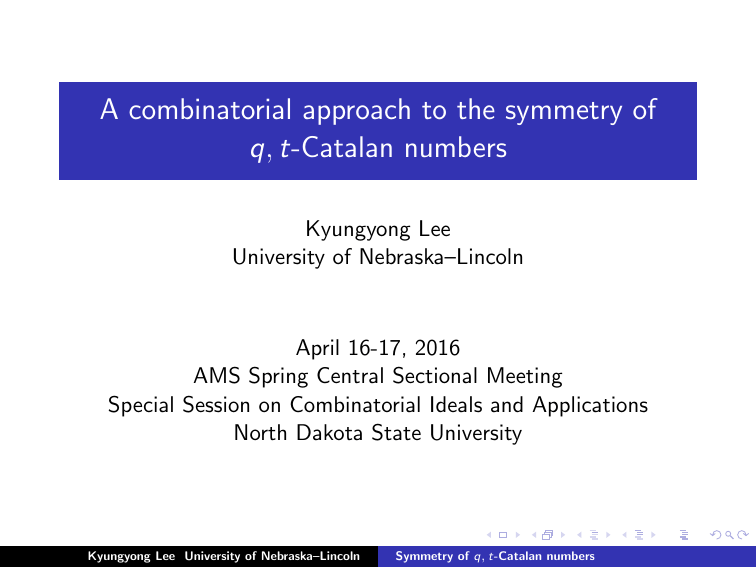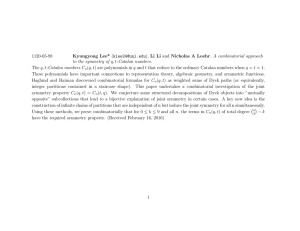A combinatorial approach to the symmetry of q, t-Catalan numbers
advertisement

A combinatorial approach to the symmetry of
q, t-Catalan numbers
Kyungyong Lee
University of Nebraska–Lincoln
April 16-17, 2016
AMS Spring Central Sectional Meeting
Special Session on Combinatorial Ideals and Applications
North Dakota State University
Kyungyong Lee University of Nebraska–Lincoln
Symmetry of q, t-Catalan numbers
Joint work with Li Li (Oakland University) and Nicholas A. Loehr
(Virginia Tech)
Kyungyong Lee University of Nebraska–Lincoln
Symmetry of q, t-Catalan numbers
The q, t-Catalan numbers have several (highly nontrivially)
equivalent definitions that connect different fields of mathematics
including commutative algebra, combinatorics, symmetric
functions, representation theory, and algebraic geometry.
Kyungyong Lee University of Nebraska–Lincoln
Symmetry of q, t-Catalan numbers
Definition of commutative algebraic q, t-Catalan numbers
• Let R = C[x1 , ..., xn , y1 , ..., yn ].
• Let I ⊂ R be the bi-graded ideal (non-minimally) generated by
the determinants of all matrices of the form
a b
x1 1 y1 1 · · · x1an y1bn
..
..
..
, ai , bi ∈ Z≥0
.
.
.
xna1 ynb1
···
xnan ynbn
Definition
The n-th (commutative algebraic) q, t-Catalan number
CA-Catn (q, t) is the q, t-Hilbert polynomial of the minimal
generators for I .
Kyungyong Lee University of Nebraska–Lincoln
Symmetry of q, t-Catalan numbers
Example
For n = 3,
1
det 1
1
the ideal is minimally generated by
1 x12 y1
x1 y1
1 x1 x12
x2 y2 , det 1 x2 x22 , det 1 x22 y2 ,
1 x3 x32
1 x32 y3
x3 y3
1 x1 y12
1 y1 y12
det 1 x2 y22 , det 1 y2 y22 .
1 x3 y32
1 y3 y32
Hence CA-Cat3 (q, t) = qt + q 3 + q 2 t + qt 2 + t 3 .
Kyungyong Lee University of Nebraska–Lincoln
Symmetry of q, t-Catalan numbers
1
1
1
1 1
1
CA-Cat3 (q, t)
1
1 1
1 1 1
1 2 1 1
2 2 1 1
.
. 3 2 1 1
.
.
. 3 2 1 1
.
.
.. 3 2 1 1
.
. 3 2 1 1
.
..
. 3 2 1 1
.
. 3 2 1 1
.
.
. 3 2 1 1
.
.
.. 2 2 1 1
1 1 1 1
1
CA-Cat6 (q, t)
Kyungyong Lee University of Nebraska–Lincoln
Symmetry of q, t-Catalan numbers
Remark
Obviously CA-Catn (q, t) = CA-Catn (t, q).
Problem
Find a set of minimal generators for I .
This is very difficult, but there is a precise conjecture (by
Can–L–Li–Loehr) using a combinatorial description.
Kyungyong Lee University of Nebraska–Lincoln
Symmetry of q, t-Catalan numbers
Definition of q, t-Catalan numbers using Dyck paths
Let Γ be a Dyck path in the n × n grid.
• area(Γ) = the number of unit boxes between Γ and the diagonal
• A box y above γ is called
good, if arm(y ) − leg(y ) ∈ {0, 1};
bad,
otherwise.
• dinv(Γ) = the number of good boxes
Example
y
leg
arm
O
X
X
O
O
O X O O
X
X
O
Kyungyong Lee University of Nebraska–Lincoln
area= 3
dinv= 7
Symmetry of q, t-Catalan numbers
Definition
X
DP-Catn (q, t) :=
q area(Γ) t dinv(Γ)
Γ:Dyck path
Theorem (Haiman, Garsia–Haglund 2001)
CA-Catn (q, t) = DP-Catn (q, t)
Corollary
DP-Catn (q, t) = DP-Catn (t, q)
Problem
Find a combinatorial proof for Corollary.
Kyungyong Lee University of Nebraska–Lincoln
Symmetry of q, t-Catalan numbers
Let defc(Γ) be the number of bad boxes above Γ, i.e.,
n
defc(Γ) :=
− area(Γ) − dinv(Γ).
2
Definition
For k ∈ Z≥0 , we define
DP-Catn,k (q, t) :=
X
q area(Γ) t dinv(Γ) .
defc(Γ)=k
Theorem (L-Li-Loehr 2016)
For k ≤ 9 and all n, we have an explicit bijection for the q, t-joint
symmetry:
DP-Catn,k (q, t) = DP-Catn,k (t, q).
Kyungyong Lee University of Nebraska–Lincoln
Symmetry of q, t-Catalan numbers
Idea of construction
Step 1 : Construct a certain infinite sequence (and its dual) of
diagrams, whose dinv are increasing by 1.
Step 2 : For each n, consider the subsequence(s) consisting of the
diagrams that fit in the n × n grid as a Dyck path.
Then the Dyck paths in this subsequence(s) have the joint
q, t-symmetry property.
Step 3 : Decompose the set of all diagrams into such infinite
sequences.
Kyungyong Lee University of Nebraska–Lincoln
Symmetry of q, t-Catalan numbers
Toy Example
X
X
X
X
X
O
X
X
O
O
col-row(+1) operation
X
X
X
O
col-row(+1) operation
X X X X X O O
O X X O O
X
X
X
col-row(+1) operation
O
Kyungyong Lee University of Nebraska–Lincoln
X X X O O O
X X O O
Symmetry of q, t-Catalan numbers
Toy Example continued
X
O
O
O
X X
X X
O O
O
col-row(+1) operation
O
X
X
O
O
O X O O
X
X
O
col-row(+1) operation
···
Let n = 6. Then the corresponding subsequence consists of the
following 4 Dyck paths:
X
X
O
O
X
X
X area= 7
O dinv= 3
O X X O O
X
X
area= 6
X
O
dinv= 4
Kyungyong Lee University of Nebraska–Lincoln
X
O
O
O
X X
X X
O O area= 4
O
dinv= 6
O
X
X
O
O
O X O O
X
X
O area= 3
dinv= 7
Symmetry of q, t-Catalan numbers





